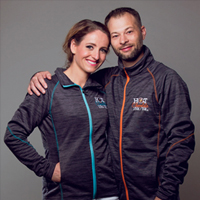.png)
RUNNING WORKOUTS
When it comes to running, there are several basic types of workouts. As someone using running as a sport, and to get the best out of myself, more than just going out for a jog is required. When I do not have a specific race coming up, I will likely do more easy and base running (explained below). When training for a race, I incorporate all of these workouts into my training cycles. They each have a specific reason to be included. My weekly schedule typically includes speed, base, tempo, and long run workouts. At least one rest day is included in every week, even when I am in heavy training mode.
If you find yourself stuck or bored in your running; change things up and have a little fun.
Easy/ Recovery Run.
This type of workout would be the easy run. This may also be considered a recovery run when it follows a particular hard workout. The real benefit of these types of runs is that they allow you to find the optimal balance between the two factors having the greatest impact on your fitness and performance: training stress and running volume. The more you get into running, the more there is a balance of these two stressors. Training stress is what is experienced during workouts that test your present limits of your running fitness. Running volume has a positive effect on running fitness within the limit of what your body can handle. The benefit of the easy/ recovery run is that your body starts out fatigued from your previous hard workout and experience a level of fatigued running without running too hard or far. The key to this run is that it still has a purpose in your overall training. Its purpose is to add some mileage without taking away from performance in the other workouts. This is best done as slowly as necessary to feel relatively comfortable despite lingering fatigue.
Base Run
This type of workout is typically a medium length run that is at the runner’s natural pace. This workout is not meant to be overly challenging, but it is meant to be done frequently. Base runs will make up the bulk of your weekly mileage. Your natural pace is the pace that you can run for an extended period of time, where you do feel as though you are neither applying the brakes nor are you stepping on the gas.
Long Run
The Long run is basically a base run that is long enough that you are left moderately to perhaps severely fatigued. The purpose of the long run is to increase your raw endurance. The distance is determined by your current level of endurance. They should be long enough that you gain confidence that your endurance will not limit you for a race.
Progression Run
This workout is sometimes known as a negative split run. It generally begins with a slower pace such as the runner’s natural pace for a certain distance. At some point in the run, the pace will increase such as to your marathon pace. It will then generally end with a faster pace still such as your 10K pace. This run is generally intended to be more challenging than base runs and easier than most harder runs such as interval runs.
Fartlek
This type of runs is essentially a base run that adds intervals of varying duration or distance. It can be a fun way to begin the process of experiencing fatigue resistance at faster speeds. This can be a less structured form of interval training. An example of such a workout would be a base run of 5 miles at your natural pace with 12 intervals of 60 second increases to your 5K pace.
Hill Runs & Repeats
Hill runs are runs where you incorporate elevation gains and losses. These runs will increase your aerobic power, fatigue resistance, pain tolerance, and run-specific strength. A hill run could be a specific distance ran over rolling terrain or a steady up-hill in one direction followed by a steady down-hill in the opposite direction. A variation of a hills run would be a hills repeat run. An example of this would be to run a couple miles easy warm up, then 12 repeats of 60 second hill repeats at hard effort with a 90 second recovery jog in between, then a 2 mile easy jog cool down.
Tempo Run
The tempo run involves a sustained effort at what is known as your lactate threshold. Your lactate threshold intensity is the fastest pace you can maintain for one hour if you are considered a highly fit or experienced runner. For the less fit runner, it is considered the fastest pace you can maintain for 20 minutes. This run serves to increase the pace you can maintain over a prolonged period of time. There are also specific types of tempo runs tailored to a specific race you are preparing for. This would be your specific race tempo such as marathon pace tempo. This would be a prolonged run at marathon pace. A great example of this would be a 16 mile total tempo run with the first 2 miles at natural pace, then next 13 miles at marathon pace, followed by the last 2 miles at natural pace.
Intervals
This workout is fairly synonymous with the speed workout.
It involves repeated shorter sections of fast running separated by slower jogging or resting recoveries. This allows you to include more fast running in a specific workout than you would otherwise with a single fast pace done to exhaustion. Interval or speed work is further subcategorized into short or longer distance intervals. These workouts are typically done on a track, where a specific distance can be easily determined. Sometimes these workouts are set-up as a form of a ladder, where you start out with shorter distance repeats (200 meters for example) and build up the ladder to a longer distance (1,600 meters for example) and then work your way back down the ladder.


.jpg)
.jpg)
.jpg)
.jpg)
.jpg)
.jpg)
.jpg)
.jpg)
.jpg)
.jpg)
.jpg)

